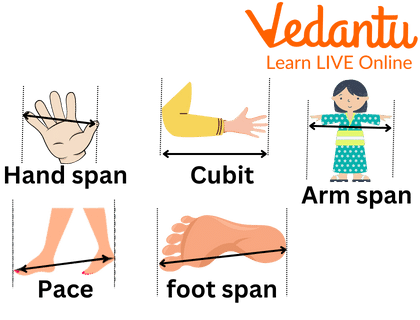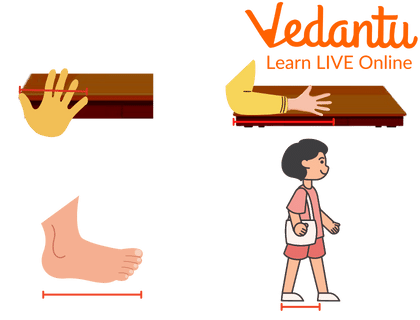




Measuring System - Introduction
A measuring system is a set of units of measurement and the rules that affect how they are related to one another. The term "measurement" comes from the Greek word "metron," which means "a small amount." In the past, humans utilised bodily parts for informal measuring systems such as foot length, cubit, handspan and so on, which were inaccurate and varied from person to person.
What are the Different Ways of Measurement?
The measurement of length of an object or distance covered can be measured using standard and non-standard ways.
Standard Measurement: The length measured using the metric system or using the defined units comes under the standard way of measurement. In these units like metre, kilometre, centimetre, decagram, and milligram are used.
Non-standard Measurement: The measurement using the body parts of the person comes under the non-standard way of measurement. The body parts like arms, hands, feet, and elbows are used for this. This is not an exact way to measure things as the length of the body parts is different from one person to another.

Non-Standard Method of Measurement
Handspan Measurement
Handspan measurement is done using the palm of the hand. The distance between the tips of the thumb and the tips of the little finger on an open palm is taken into account. The length of the palm of the hand is different for every person. It can be used to measure the length of your books or your water bottle. Long distances like the distance from your school to your home can’t be measured using the palm of your hand.
Cubit Measurement
The cubit length or the length from the elbow to the tip of the fingers can be used to measure length. The cubit measurement can be used to measure objects like clothes, tables, beds and chairs but cannot be used for the longer distances of large objects like walls.
Footspan Measurement
The foot span measurement is done by the tip of the toe and the heel of the foot. The floor can be measured using this type of measurement but it would be very time-consuming. The length of the foot is different for every person and the measurement done using this can vary.
Pace Measurement
Natural walking can also be considered a way to measure distances. Pace measurement or stride measurement is taken by placing the right foot forward followed by the left foot. The footsteps can be counted easily and large distances like the distance from school to home can be measured using pace measurement. But if there is a change in the length of the pace being followed, then it could lead to a wrong calculation of the distance.
Arm Span
Arm span or reach is the physical length measured from one end of an individual's arms (measured at the fingertips) to the other when lifted parallel to the ground at shoulder height at a 90 angle (also referred to as wingspan, or written arm span). We'll use our arm span as a reference to measure the length of the fabric. When determining height, the arm span is sometimes used.

Measuring Objects Using Different Methods
Sample Questions
1. What can be used to measure the length of an object?
Vegetable
Fruits
body parts
Clothes
Ans: Body parts
2. Length of a table can be measured by?
Palm of hand
Foot
through pace measurement
None of the above
Ans: palm of the hand
3. The standard measurement is done using the?
Ruler
Inchtape
metre stick
All of the above
Ans: All of the above
Conclusion
The objects and the distance can be measured using the standard and the non-standard ways. The non-standard ways are not very accurate and would change from person to person. The standard methods are accurate and we can change the unit of the length according to the units that we need.
FAQs on Measuring System
1. What is a measuring system in Maths?
A measuring system is a set of defined units of measurement and the rules for using them to quantify properties like length, weight, or capacity. It provides a standard way to describe the size of an object, ensuring that everyone understands the quantity in the same way. For example, using metres to measure a room's length is part of a recognised measuring system.
2. What is the difference between standard and non-standard units of measurement?
The main difference is consistency. Standard units, such as the metre, kilogram, and litre, have a fixed and universally accepted value, meaning they are the same for everyone, everywhere. In contrast, non-standard units like a handspan, a cubit, or a footstep vary from person to person and are not precise enough for official or scientific use.
3. What are the two main systems of measurement used in the world?
The two primary systems are the Metric System (also known as the International System of Units or SI) and the Imperial System. The Metric System is used by most countries and is based on units like the metre (for length), gram (for mass), and litre (for volume). The Imperial System is primarily used in a few countries, like the United States, and features units such as feet, inches, pounds, and gallons.
4. Why is it important to use a standard measuring system for things like science and trade?
Using a standard measuring system is crucial for ensuring fairness, consistency, and accuracy. It guarantees that a 'kilogram of sugar' is the same amount in every shop and in every country. This is essential for global trade, scientific experiments, and engineering, as it eliminates confusion and allows for precise, repeatable results that everyone can rely on.
5. What are the three basic types of measurement introduced in the primary Maths syllabus?
In primary classes, students are typically introduced to three fundamental types of measurement as per the CBSE syllabus:
Length: Measures how long or far something is, using units like centimetres (cm) and metres (m).
Mass (or Weight): Measures how heavy an object is, using units like grams (g) and kilograms (kg).
Capacity (or Volume): Measures the amount of liquid a container can hold, using units like millilitres (ml) and litres (l).
6. What are some common examples of non-standard units used to estimate length?
Before standard tools were widely available, people used parts of their body or common objects for estimation. Common examples include:
Handspan: The distance from the tip of the thumb to the tip of the little finger of a stretched hand.
Cubit: The distance from the elbow to the tip of the middle finger.
Foot span: The length of a person's foot from heel to toe.
Pace: The length of a single step while walking.
7. How are length, weight, and capacity measured using standard tools?
We use specific, calibrated tools to measure different quantities accurately. To measure length, we use a ruler, measuring tape, or a metre stick. For weight (mass), we use a weighing scale or a balance. To measure capacity, we use measuring cups, beakers, or cylinders that are clearly marked with units like millilitres (ml) and litres (l).
8. What are the seven base units in the International System of Units (SI)?
The International System of Units (SI) is the modern form of the metric system and is built upon seven base units from which all other units are derived. These fundamental units are:
The metre (m) for length.
The kilogram (kg) for mass.
The second (s) for time.
The ampere (A) for electric current.
The kelvin (K) for thermodynamic temperature.
The mole (mol) for the amount of a substance.
The candela (cd) for luminous intensity.









